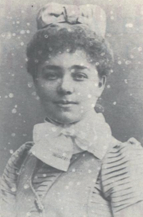CHATFIELD, Mabel Jesson
Biography
Mabel Jesson Chatfield was born in Quaggerfontein in the Bloemfontein district of South Africa, on June 12, 1875. Her father had emigrated to South Africa and was a farmer. When she was 17 Mabel asked Sister Henrietta Stockdale at Kimberley Hospital if she could be a nurse. She was told she was too young, so she set up a dance school instead. When Sister Henrietta left Kimberley Hospital to set up a private institution in Bloemfontein, Mabel reapplied to Kimberley Hospital and was accepted. Se then had to wait another eighteen months for a place and started her training in 1895. She was very proud of her pink and white striped uniform with her ‘Sister Dora’ hat. She finished her training shortly before the siege of Kimberley at the start of the Boer War[1]
Nursing Service in the Boer War
She trained as a nurse in Kimberley and was employed there at the start of the war[2] [3]. She wrote about her time as a nurse during the siege[1]:
Throughout the greater part of the siege I was alone on night duty with some 30 patients under my care. The only assistance was provided by a Tswana whose duty it was to empty the bedpans and keep the small coal stove burning for hot water or any of the other various needs which require a stove.
After the siege was lifted she was approached by the military to take charge of a temporary hospital. When she accepted she was taken into the Princess Christian's Army Nursing Service (Reserve). Shortly after taking over the hospital a convoy of 115 sick and wounded soldiers arrived, and she had to get them settled and start nursing care 4. She wrote of this temporary hospital[4]:
This was nursing under the most difficult circumstances imaginable. All types of cases ranging from severely wounded, to the dangerously ill with typhoid, had perforce to be attended to in the grossly overcrowded rooms. It was more often than not necessary to step over a number of patients in order to reach one requiring urgent treatment. We tried our utmost to keep the infectious cases apart but this was only possible to a limited extent.
Eventually beds arrived and along with other items donated to the hospital she was able to make her patients more comfortable. After six weeks she handed over this temporary hospital to six nurses from Canada. Sister Chatfield was then instructed to report to No. 1 General Hospital at Wynberg where Mrs Garriock was the Matron. At Wynberg Sister Chatfield looked after a variety of patients including sick and wounded Boer prisoners. It was here that she was able to go to a local tailor and get a military nurses uniform made for her. She worked at Wynberg for six months before asking to go on duty aboard a troop ship carrying sick and wounded back to Britain. She sailed on the Assaye along with seven other Sisters and fifteen hundred patients. While she was in Britain she was officially attested into the Princess Christian’s Army Nursing Service (Reserve). Shortly after she was sent back to South Africa on the Norman along with other nurses reinforcing the Imperial Yeomanry Hospital at Pretoria. The nurse-patient ratio was greater in the Yeomanry Hospitals as many of the Sisters had salaries paid for from the private funds collected for the hospitals[4] [5].
After a further six months working with the Imperial Yeomanry Hospitals[6] she was able to get a posting to the Hospital Ship Orcana[7] where she met up with another South African nurse, Sister Rennie. She was happier on the Orcana than she had been on the Assaye as it was a fully equipped Hospital Ship and that made nursing care much easier. Sister Chatfield and Sister Rennie met the Duchess of Teck when they arrived in England and were her guests for a short while. Sister Chatfield then resigned from the PCANS(R) in order to return home to South Africa to get married. Having resigned she discovered that it was very difficult to get a berth back home and she was told it might be six months before a berth became available. She wrote to the Duchess and was shortly booked onto the Walmer Castle. She married Dr Howell-Davies in Kimberley on December 13, 1902. Before they had a chance to return to Wales to visit his family Dr Howell-Davies was placed in charge of the Irene Burgher Camp and so she helped her husband and continued nursing for a while longer. She had four children, and her daughter Kathleen, and Kathleen’s daughter Anne both trained as nurses[8].
References
- ↑ 1.0 1.1 Stratford, DO. (1991) Nursing one hundred years ago. Part 1. Nursing RSA Verpleging. 6(8):9-11.
- ↑ The National Archives: Defence of Kimberley Medal Roll AG2/M/2426 p148 created at Civil Hospital, Kimberley; January 3, 1930
- ↑ The National Archives: WO 100/229 QSA Medal Roll p148 created at The Kimberley Hospital
- ↑ 4.0 4.1 Stratford, DO. (1991) Nursing one hundred years ago. Part 2. Nursing RSA Verpleging. 6(9):6-8
- ↑ The National Archives: WO 100/229 QSA Medal Roll p7 created at No1 General Hospital, Wynberg; dated July 14, 1901
- ↑ The National Archives: WO 100/130 QSA Medal Roll p228 created at The Imperial Yeomanry Hospital, Pretoria; dated July 13, 1901
- ↑ London Times, June 24, 1902 p5c
- ↑ Stratford, DO. (1991) Nursing one hundred years ago. Part 3. Nursing RSA Verpleging. 6(10):9-11

